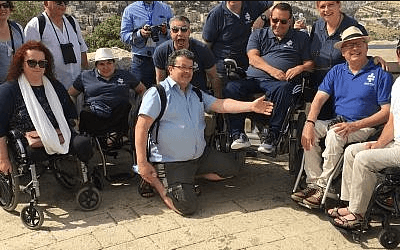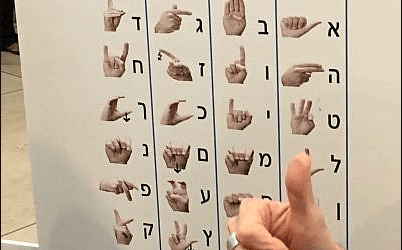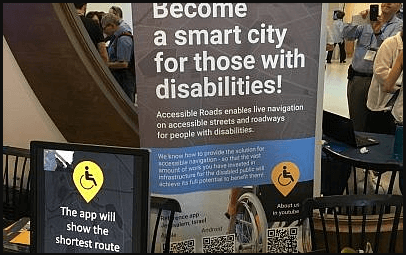Original Article Published on The Jerusalem Post
Over 800 people from 22 countries participated in Access Israel’s 7th International Conference.
When paralyzed former helicopter pilot Yuval Wenger wrote in 1998 to a fellow former pilot, President Ezer Weizman, to complain about lack of access in Israel for people with disabilities, he didn’t expect a prompt reply – and a demand. Wenger followed Weizman’s terse response to do something about it and start an NGO. He called it Access Israel, and six months later met Weizman at the President’s Residence. Twenty years later, Access Israel’s impact on access and inclusion of people with disabilities is now felt worldwide.
Over 800 people from 22 countries participated in Access Israel’s 7th International Conference, which was held last month in Tel Aviv and throughout the country. The fast-paced conference, entitled “The Future of Accessibility,” kept participants moving – between sessions within a given event space, and to various cities in Israel.
Meetings on the first day of the conference were held at the Export Institute in Tel Aviv, where participants were welcomed by representatives of the Foreign Affairs and Tourism ministries. They were later welcomed by Avremi Torem, Commissioner for Equal Rights of Persons with Disabilities in Israel. Some participants toured and experienced disabilities simulation activities at Wingate Institute, Israel’s National Center for Physical Education and Sport.
Friday was spent in Jerusalem, viewing the city from Mt. Scopus, and touring such sites in the now-accessible Old City as the Church of the Holy Sepulcher and the Western Wall. The international delegation continued to bond at a traditional Shabbat dinner at Wegner’s home, and during Shabbat tours of Tel Aviv-Jaffa, including several of Tel Aviv’s accessible beaches.
A NUMBER of sessions took place at Avenue Convention and Events Center in Airport City and at Beit Hagimlai in Shoham. Many were attended by Israeli disability professionals, representatives of municipalities, ministries, banks, insurance companies, accessibility coordinators from leading companies in Israel, IT and website experts, representatives of Israeli technologies, CEOs of Israeli accessibility start-ups and companies and policy makers.
Conference attendees and presenters included many people with visible disabilities, including app and product designers from around the world, commissioners on disabilities from the mayor’s offices of New York and Chicago, and even the co-founder of Space IL, Yariv Bash, paralyzed from the waist down two years ago in a French skiing accident.
Attendees heard from access and inclusion experts on such topics as Accessible Technology; Barrier-Free Tourism; Urban Accessibility Initiatives and Challenges from Around the World; and Global Models for the Implementation of Technology. And they participated in customized sessions – and panels – on such topics as Inclusive Design, Culture for All, Justice and Democracy for All, Inclusive Education, Inclusive Technology, Accessible Websites and Applications and Workplace Accessibility.
The conference’s largest delegation came from Austria (20 people), with Google’s Accessibility Team coming in second place with seven representatives. Google Israel hosted a well-received Accessible Technologies Speed Dating event where pairs of delegates spent ten minutes at each of seven stations, learning about such technologies as StepHear (orientation and guidance systems for the blind and visually impaired), Travaxy (accessible travel), Accessible Roads (navigation on accessible streets and roadways) and SignTime (translates texts in to sign languages).
VIENNA RESIDENT Hugo Furtado displayed his Dreamwaves Navigation System at the Google-hosted event. The Portuguese-born PhD completed his electrical engineering training in Switzerland, Slovenia and Austria, and has created a navigation system to guide blind and visually impaired people in unknown environments.
“I attended the event because I had heard that the topic of accessibility has become very important in recent years,” he said.
The well-traveled Furtado was particularly excited to make his first trip to Israel. “Israel is a famous start-up nation. Within this framework, it was a great opportunity for me to learn and to further develop the business. As Dreamwaves is a start-up developing a navigation app for blind and low-vision people, the fit could hardly be better,” he said. “Both things were confirmed: One can see the big effort that is being put into making the public spaces accessible – I can imagine the challenge to make visiting Jerusalem accessible – and bringing the topic into the authorities’ agenda.
“Also, it was especially valuable for me to learn why Israel is such a strong start-up nation. In my view, the energy and will power that people put into what they do plays a huge role. This was impressive for me in the country in general. People put a lot of energy into making things happen instead of worrying about smaller detail. That’s what you need in a start-up,” Furtado said.
Others came from Sweden, Latvia, Chile, Bulgaria, Canada, Germany, Ireland and Australia. Some has been to Israel four or five times – like Martin Essl, head of the Essl Foundation, which coordinates The Zero Project, focusing on the rights of persons with disabilities globally. It also focuses on social projects in Austria, with an emphasis on the inclusion of persons with disabilities in the open labor market, and in accessibility and inclusive education.
The excitement for Israel on the part of foreign attendees was a familiar trope; they consider Israel to be the Start-Up Nation and a world-leader in accessibility and inclusion.
KJELL STJERNHOLM of Stockholm, Sweden, was invited to the conference by Access Israel after having been awarded an international best practice by Zeroproject.org. The good natured Stjernholm, who founded and directed a disabilities acting troupe in Sweden where actors were paid market wages, currently works in the field of accessible elections. In this capacity, Stjernholm is working to teach people “what we are voting about,” and to assure that “the very politics needs to be accessible.”
Stjernholm enjoyed both the conference and the country. “I’ve learned heaps of things. Among the most usable to me: interpretation techniques within easy read, accessibility to the arts and some amazing tech-projects.” He says that, “Israel is a beautiful country. I am impressed by the high aims of accessibility, and the use of the law to enforce it,” referring to a law where government-funded bodies with more than 100 employers are committed to ensuring that at least five percent of its workforce are employees with disabilities.
IRISH INCLUSIVITY activist, Caroline Casey – whose TED Talk, “Looking Past Limits,” has had more than 2.2 million viewers – described learning about her near total blindness due to ocular albinism – she had unknowingly been diagnosed with it as a child – at age 17. She left a promising career in managing consulting and has committed her career to inclusion in general, and to inclusion in the work place in particular.
Casey was curious to visit Israel for the first time, since her father had shared stories about his time here in the early 60s while he was living on a kibbutz. Prior to her visit, she noted that: “Over the years, I have witnessed the extraordinary development and impact of Access Israel. It has truly amazed me how far both the country and the organization have come in their accessibility journey.”
The inclusivity activist loved what she saw and experienced in Israel. “The food, the archaeology, the history, the heat, the sense of historic civilization – for an ex-archaeologist – unbelievable,” reported Casey. “But no doubt: The real draw was and is the people. I love their energy, their straightness, their attitude to “getting stuff done”; their warmth, humor and ambition. They seem to work with the intention of solutions, not problems.”
Casey followed Space IL co-founder Yariv Bash and Bank HaPoalim CTO, Haim Pinto, by delivering what were billed as “Inspiring Opening Lectures” on the Sunday of the conference. Casey, like most attendees, raced between sessions, met with colleagues and made many new friends.
And she never stopped appreciating the fact that she was in Israel. “It was so great to go to a global conference like that and it not be in the ‘typical’ place,” she said. “I think we can learn a huge amount by going to different places and immersing ourselves in cultures completely different from our own – and I knew so little about Israel, I wanted more time there – much more.”
Casey and hundreds of others will surely be back for next year’s 8th International Conference.








